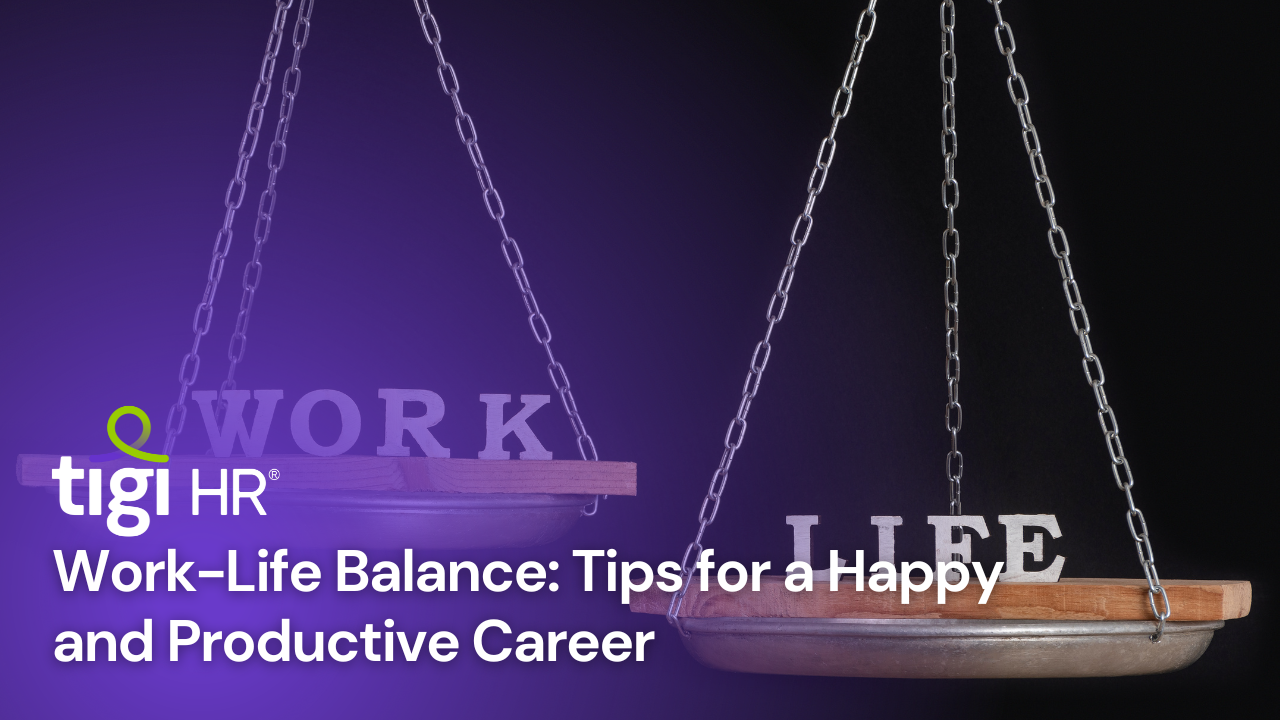In today’s fast-paced world, achieving a harmonious work-life balance has become more challenging than ever. Balancing the demands of a career with personal life can be a daunting task. However, finding this equilibrium is crucial for not only maintaining our well-being but also ensuring long-term career success. In this comprehensive guide, we will explore various aspects of work-life balance and provide you with practical tips to lead a happier and more productive professional life.
1. Introduction
Defining Work-Life Balance
Work-life balance refers to the equilibrium between the demands of one’s professional life and personal life. It involves allocating time, energy, and attention to work-related responsibilities and personal well-being, family, and leisure activities. Achieving this balance is essential for maintaining overall happiness and productivity.
Why It Matters
Work-life balance is not a luxury but a necessity. Failing to find this equilibrium can lead to various negative consequences, affecting both your career and personal life. Let’s delve deeper into these repercussions.
2. The Consequences of Imbalance
Burnout and Its Symptoms
One of the most significant consequences of an imbalanced life is burnout. Burnout is a state of emotional, mental, and physical exhaustion caused by prolonged exposure to high levels of stress. Common symptoms include chronic fatigue, reduced motivation, and feelings of cynicism towards work.
Impact on Physical and Mental Health
Work-life imbalance can take a toll on your physical and mental health. Increased stress levels can lead to conditions like hypertension, anxiety, and depression. It’s crucial to recognize the signs early and take action to prevent these issues.
Strained Relationships
A lack of work-life balance can strain personal relationships. Neglecting family and friends due to work commitments can lead to conflicts and feelings of isolation. A balanced life allows you to nurture and enjoy your relationships outside of work.
3. The Benefits of Work-Life Balance
Enhanced Productivity
Contrary to the belief that working longer hours equals greater productivity, maintaining a balance between work and personal life can actually enhance your performance. When you are well-rested and mentally refreshed, you can tackle tasks with more focus and efficiency.
Improved Mental Health
Prioritizing your well-being contributes to better mental health. Regular breaks and time for self-care activities reduce stress and promote a positive mindset, ultimately leading to greater job satisfaction and career longevity.
Stronger Personal Relationships
Balancing work and personal life allows you to invest time and effort into building and maintaining meaningful relationships. Healthy personal connections provide emotional support and fulfillment, which can positively impact your professional life.
4. Assessing Your Current Work-Life Balance
Self-Reflection
Begin your journey toward better work-life balance by reflecting on your current situation. Consider how you spend your time and whether it aligns with your priorities. Identifying areas of improvement is the first step toward change.
Setting Priorities
Determine your top priorities in both your career and personal life. Knowing what truly matters to you will help you make informed decisions about how to allocate your time and energy effectively.
5. Tips for Achieving Work-Life Balance
Now that we’ve explored the importance of work-life balance, let’s delve into practical tips to help you achieve this equilibrium in your career and personal life.
Time Management Techniques
The Pomodoro Technique
The Pomodoro Technique is a popular time management method that involves working in short, focused bursts followed by short breaks. This technique can boost productivity by helping you stay on task and preventing burnout.
Eisenhower Matrix
The Eisenhower Matrix is a tool for prioritizing tasks based on their urgency and importance. By categorizing your to-do list, you can allocate your time more effectively and reduce stress.
Time Blocking
Time blocking involves scheduling specific blocks of time for different tasks or activities. It helps you allocate time for work, personal life, and self-care, ensuring you don’t neglect any aspect of your life.
Setting Boundaries
Establishing clear boundaries between work and personal life is essential. Communicate your boundaries to colleagues and supervisors to prevent work from encroaching on your personal time.
Effective Delegation
Don’t hesitate to delegate tasks when possible. Delegation not only lightens your workload but also provides opportunities for others to learn and grow.
Embracing Flexibility
While setting boundaries is important, it’s also crucial to embrace flexibility. Life is unpredictable, and sometimes you may need to adjust your schedule to accommodate unexpected events or opportunities.
Mindfulness and Meditation
Practicing mindfulness and meditation can help reduce stress and increase your ability to stay present in both your work and personal life. These practices promote emotional resilience and mental clarity.
6. Work-Life Balance for Remote Workers
Challenges of Remote Work
Remote work offers flexibility but also comes with unique challenges. Isolation, blurred boundaries, and the temptation to overwork are common issues for remote workers.
Establishing a Dedicated Workspace
Creating a dedicated workspace at home helps separate work from personal life. Having a designated area for work can improve focus and productivity.
Creating a Daily Routine
Establishing a daily routine can provide structure to your remote workdays. Set specific start and end times for work, as well as breaks, to maintain a sense of normalcy.
Disconnecting from Work
One of the pitfalls of remote work is the difficulty in disconnecting from work. Set clear boundaries for when work ends, and leisure time begins. Avoid checking work-related emails or messages outside of designated work hours.
7. Incorporating Exercise and Healthy Eating
The Role of Physical Health
Physical health plays a significant role in maintaining work-life balance. Regular exercise and a balanced diet can boost your energy levels and overall well-being.
Simple Exercises for Desk Workers
If your job involves long hours at a desk, incorporate simple exercises into your day. Stretching, walking breaks, and desk exercises can prevent the negative effects of prolonged sitting.
Nutritional Tips for a Balanced Life
Eating a nutritious diet provides the energy needed to excel in your career and enjoy your personal life. Opt for balanced meals rich in fruits, vegetables, lean proteins, and whole grains.
8. The Importance of Hobbies and Interests
Discovering Your Passions
Hobbies and interests are not just leisure activities; they are essential for personal growth and fulfillment. Explore different hobbies to discover what brings you joy and relaxation.
How Hobbies Relieve Stress
Engaging in hobbies can be a powerful stress reliever. Hobbies provide an escape from work-related pressures and offer a sense of accomplishment.
Balancing Work and Play
Integrating hobbies into your routine helps maintain balance. Schedule time for your interests just as you would for work tasks, ensuring you don’t neglect the things that make you happy.
9. Effective Communication with Employers
Negotiating Flexible Work Arrangements
If your work situation allows, consider negotiating for flexible work arrangements. Discuss options like telecommuting, compressed workweeks, or job sharing with your employer.
Open Dialogues About Workload
Open and honest communication with your employer is crucial. If you find your workload overwhelming, address it promptly. Collaborate to find solutions that promote a healthier work-life balance.
Seeking Support When Needed
Don’t hesitate to seek support from your HR department or Employee Assistance Program if you’re struggling to maintain balance due to workplace stressors.
10. Taking Time Off: Vacation and PTO
The Value of Vacation
Vacations are essential for recharging and rejuvenating. They offer a break from the daily grind, allowing you to return to work with renewed enthusiasm and creativity.
Planning and Disconnecting
When planning a vacation, ensure you disconnect from work completely. Inform colleagues and clients well in advance, set up out-of-office notifications, and resist the urge to check work-related emails or messages while away.
The Benefits of Paid Time Off
Take advantage of your paid time off (PTO) benefits. Paid leave is not just a perk; it’s a vital component of maintaining work-life balance. Use your PTO to prioritize your personal life and well-being.
11. The Role of Technology in Work-Life Balance
Managing Screen Time
Excessive screen time, both at work and during personal time, can contribute to burnout and stress. Set limits on screen time and prioritize face-to-face interactions.
Utilizing Productivity Apps
Numerous productivity apps are available to help you manage your tasks, set reminders, and stay organized. These tools can streamline your work processes and free up time for other activities.
Unplugging from Digital Distractions
Constant connectivity can hinder your ability to disconnect from work. Create technology-free zones or times during your day to recharge and reduce the temptation to check work-related messages.
12. Cultivating a Supportive Work Environment
Fostering a Culture of Balance
Employers can play a significant role in promoting work-life balance. Encourage your workplace to foster a culture that values employees’ well-being and supports their efforts to maintain balance.
Encouraging Employee Well-being Programs
Many organizations offer employee well-being programs that include fitness classes, mental health resources, and stress management workshops. Take advantage of these programs to enhance your work-life balance.
Peer Support Networks
Build connections with colleagues who understand the importance of work-life balance. Peer support networks can provide advice, encouragement, and a sense of camaraderie in your quest for balance.
13. Overcoming Common Obstacles
Fear of Falling Behind
One common obstacle to work-life balance is the fear of falling behind at work. Recognize that achieving balance can actually improve your performance and reduce the risk of burnout.
Guilt About Taking Breaks
Feeling guilty about taking breaks is another hurdle. Remember that breaks are essential for productivity and well-being. Use this time to recharge and return to work more focused.
Resistance from Employers
Some employers may resist efforts to achieve work-life balance, especially if they prioritize long working hours. In such cases, consider discussing the benefits of balance and presenting evidence of increased productivity.
14. Maintaining Long-Term Work-Life Balance
Continual Self-Assessment
Work-life balance is not a one-time achievement but an ongoing process. Regularly assess your priorities, adjust your strategies, and make necessary changes to maintain balance as your life evolves.
Adaptation to Life Changes
Life circumstances change over time, whether due to family dynamics, career progression, or personal interests. Be flexible and adapt your balance strategies to align with your current situation.
Seeking Professional Help When Necessary
If you find it challenging to achieve work-life balance due to persistent stress, anxiety, or other mental health issues, don’t hesitate to seek professional help. A therapist or counselor can provide guidance and support.
15. Financial Planning for Work-Life Balance
Creating a Budget
Financial stress can significantly impact your work-life balance. To alleviate this stress, create a budget that allows you to manage your finances effectively. Knowing where your money goes and having a plan for saving and investing can provide peace of mind.
Emergency Funds
Building an emergency fund can provide a safety net during unexpected financial crises, reducing the anxiety that often spills over into your personal life. Aim to save at least three to six months’ worth of living expenses.
Retirement Planning
Investing in retirement accounts ensures your long-term financial stability, which can alleviate concerns about working indefinitely. Consult a financial advisor to create a retirement plan that aligns with your work and life goals.
16. Work-Life Balance for Parents
Balancing Parenthood and Career
Parents face unique challenges in achieving work-life balance. Managing childcare, school activities, and personal time requires careful planning and support. Flexible work arrangements and reliable childcare services are essential.
Co-Parenting Strategies
For couples, effective co-parenting strategies can distribute parenting responsibilities more evenly. Open communication and shared schedules can help ensure both partners have time for their careers and personal lives.
Quality Family Time
Prioritize quality family time over quantity. Engage in activities that promote bonding, such as family outings, game nights, or shared hobbies, to strengthen your relationships with your children.
17. Work-Life Balance for Students
Managing Academics and Personal Life
Students often face the challenge of balancing their academic commitments with personal life and part-time jobs. Time management, study routines, and setting realistic goals are essential skills for student work-life balance.
Internships and Career Prep
As students transition to the workforce, internships and career preparation become vital. These experiences can be demanding, so finding ways to balance them with coursework and personal time is essential for well-being.
Building Support Networks
Connecting with peers who share similar academic and career goals can provide emotional support and valuable advice on managing the demands of student life.
18. The Role of Sleep in Work-Life Balance
The Importance of Sleep
Adequate sleep is fundamental to maintaining work-life balance. Poor sleep quality and insufficient sleep can lead to irritability, decreased productivity, and health issues. Aim for 7-9 hours of quality sleep each night.
Creating a Sleep Routine
Establish a consistent sleep routine by going to bed and waking up at the same times each day. Avoid screens before bedtime and create a calming pre-sleep ritual to signal your body that it’s time to rest.
Napping for Productivity
Strategic napping can boost productivity and mental clarity. A short power nap during the day can provide an energy boost without interfering with your nighttime sleep.
19. Balancing Multiple Roles
Multifaceted Identities
Many individuals juggle multiple roles, such as being a parent, a professional, a caregiver, and more. Recognize and embrace your multifaceted identity, understanding that you don’t have to excel in every role all the time.
Effective Time Management
Balancing multiple roles requires excellent time management. Prioritize tasks, delegate when possible, and use time-blocking techniques to allocate your time effectively.
Seeking Support Systems
Lean on support systems, such as friends, family, or support groups, to help you navigate the challenges of balancing multiple roles. These networks can provide guidance, emotional support, and valuable insights.
20. The Future of Work-Life Balance
Remote Work Evolution
The concept of work-life balance is evolving alongside changes in the workplace. Remote work, flexible schedules, and gig work are reshaping how we perceive and achieve balance.
Automation and Artificial Intelligence
As automation and AI play a more significant role in the workforce, some tasks may become more efficient, potentially reducing the need for long working hours. Embrace these technologies to enhance your work-life balance.
Continuous Learning and Adaptation
To maintain work-life balance in the future, be prepared to continually learn and adapt. Develop skills that are in demand in the changing job market and stay open to new work arrangements.
21. Balancing Generational Differences
Millennials vs. Gen Z
Different generations often have distinct approaches to work-life balance. Millennials may value flexibility and purpose-driven work, while Gen Z might prioritize tech-savvy solutions and a healthy work environment. Understanding these generational differences can foster collaboration and innovation in the workplace.
Bridging the Generation Gap
To create a harmonious work environment, it’s essential to bridge the generation gap. Encourage cross-generational mentorship and knowledge sharing to benefit from the strengths and perspectives of each generation.
22. Sustainable Work-Life Balance
Eco-Friendly Work Practices
Sustainability extends beyond the environment. Adopting eco-friendly work practices, such as remote work to reduce commuting or energy-efficient office spaces, can align your career with your values and contribute to a sustainable future.
Mental Sustainability
Promoting mental sustainability involves strategies for long-term well-being. Focus on stress management, resilience-building, and coping mechanisms to ensure that your work-life balance is not just temporary but sustainable throughout your career.
23. The Role of Creativity in Balance
Nurturing Creativity
Creativity can thrive when work and personal life are balanced. Make time for creative pursuits, whether it’s writing, painting, or playing music. These activities can be a source of fulfillment and relaxation.
Creative Problem-Solving
Creativity isn’t limited to artistic endeavors; it can also enhance problem-solving at work. A balanced mind often leads to innovative solutions and fresh perspectives in your professional life.
24. Achieving Balance in a Gig Economy
The Rise of Gig Work
The gig economy offers flexibility but comes with its own set of challenges. Gig workers must manage their own schedules and benefits. Strategies for budgeting, retirement planning, and finding a work-life balance are crucial for gig workers.
Balancing Multiple Gig Jobs
Many individuals work multiple gig jobs to make ends meet. Effective time management and setting boundaries between gigs are essential to prevent burnout and maintain personal time.
25. The Impact of Social Media
Digital Detox
Social media can blur the lines between work and personal life. Regular digital detoxes and setting boundaries for social media use can help you disconnect and recharge.
Networking and Career Growth
On the flip side, social media can be a valuable tool for career growth and networking. Balance your online presence by leveraging social media for professional purposes while maintaining personal boundaries.
26. Work-Life Balance for Entrepreneurs
The Entrepreneurial Journey
Entrepreneurs often face unique challenges in achieving work-life balance. The demands of starting and running a business can be all-consuming. Effective time management and delegation are critical for entrepreneurial success.
The Importance of Delegation
Entrepreneurs often wear multiple hats. Learning to delegate tasks and responsibilities is vital to prevent burnout and maintain a balanced life.
27. The Role of Volunteering
Giving Back
Volunteering can be a fulfilling way to balance your life. Contributing to causes you’re passionate about can provide a sense of purpose beyond your career.
Skills Development
Volunteering can also offer opportunities to develop new skills, expand your network, and gain experiences that can benefit your professional life.
28. Building Resilience
Overcoming Challenges
Resilience is the ability to bounce back from adversity. Developing resilience skills can help you navigate setbacks in your career and personal life while maintaining overall balance.
Self-Care as a Resilience Tool
Prioritizing self-care, both physically and mentally, is a key component of resilience. Regular self-care practices can equip you to handle stress and challenges effectively.
Conclusion
In a world where work demands can be all-encompassing, finding and maintaining work-life balance remains a critical pursuit. We’ve explored various aspects of work-life balance, from time management to financial planning, and from parenting to student life.
By implementing the tips and strategies outlined in this guide and adapting them to your unique circumstances, you can achieve a work-life balance that enhances your overall well-being and leads to a happier, more productive life.
Remember, work-life balance is not a one-size-fits-all concept. It’s a personal journey that requires continual adjustment and self-awareness. Embrace this journey, prioritize your well-being, and enjoy the benefits of a fulfilling and sustainable career and personal life.
Find trusted recruitment agencies: Click here





